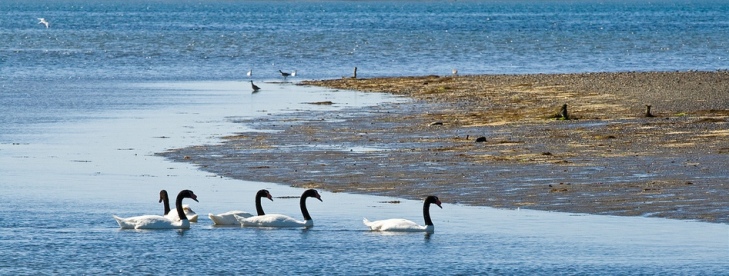"I'll Stand By You"...Reproduction
As mentioned briefly in the habitat
section, during mating
season, black-necked swans separate from the flock into their mating
pairs. Black-necked
swans mate for life, becoming very territorial and aggressive during
nesting. These swans,
which are normally very social, become very d efensive and will
pursue any intruder that ventures near their
nest, attempting to
bite or beat them with their wings.
Black-necked swans are typically very quiet birds, but during
their breeding season both sexes are extremely vocal.
The male swan courts the female through a series of calls and
head tilts. During
breeding season, the red knob at the base of the beak of the male
swan becomes dark scarlet and enlarged.
The breeding season lasts from July to September with females
laying four to six eggs at a time, up to three times a season.
The female swan, known as a pen, is the only one who can sit
on the eggs, while the male (cob) protects the nest and brings her
food. After around 25
days the eggs hatch and the cygnets (baby swans) are dependent on
their parents for their first year of life.
Black-necked swans are unique in that both of the parents carry
their young on their back continuously for the first three weeks of
life. This bird molts
(loses its flight associated feathers) once a year, males and females
at different times. The
female swan becomes flightless soon after breeding, spending her
time incubating the eggs.
The males molt only after the female is finished. The swans do
this at different times so that one of the parents is always ready
to defend their young.
efensive and will
pursue any intruder that ventures near their
nest, attempting to
bite or beat them with their wings.
Black-necked swans are typically very quiet birds, but during
their breeding season both sexes are extremely vocal.
The male swan courts the female through a series of calls and
head tilts. During
breeding season, the red knob at the base of the beak of the male
swan becomes dark scarlet and enlarged.
The breeding season lasts from July to September with females
laying four to six eggs at a time, up to three times a season.
The female swan, known as a pen, is the only one who can sit
on the eggs, while the male (cob) protects the nest and brings her
food. After around 25
days the eggs hatch and the cygnets (baby swans) are dependent on
their parents for their first year of life.
Black-necked swans are unique in that both of the parents carry
their young on their back continuously for the first three weeks of
life. This bird molts
(loses its flight associated feathers) once a year, males and females
at different times. The
female swan becomes flightless soon after breeding, spending her
time incubating the eggs.
The males molt only after the female is finished. The swans do
this at different times so that one of the parents is always ready
to defend their young.
 |
| Parent swan carrying a cygnet. |
